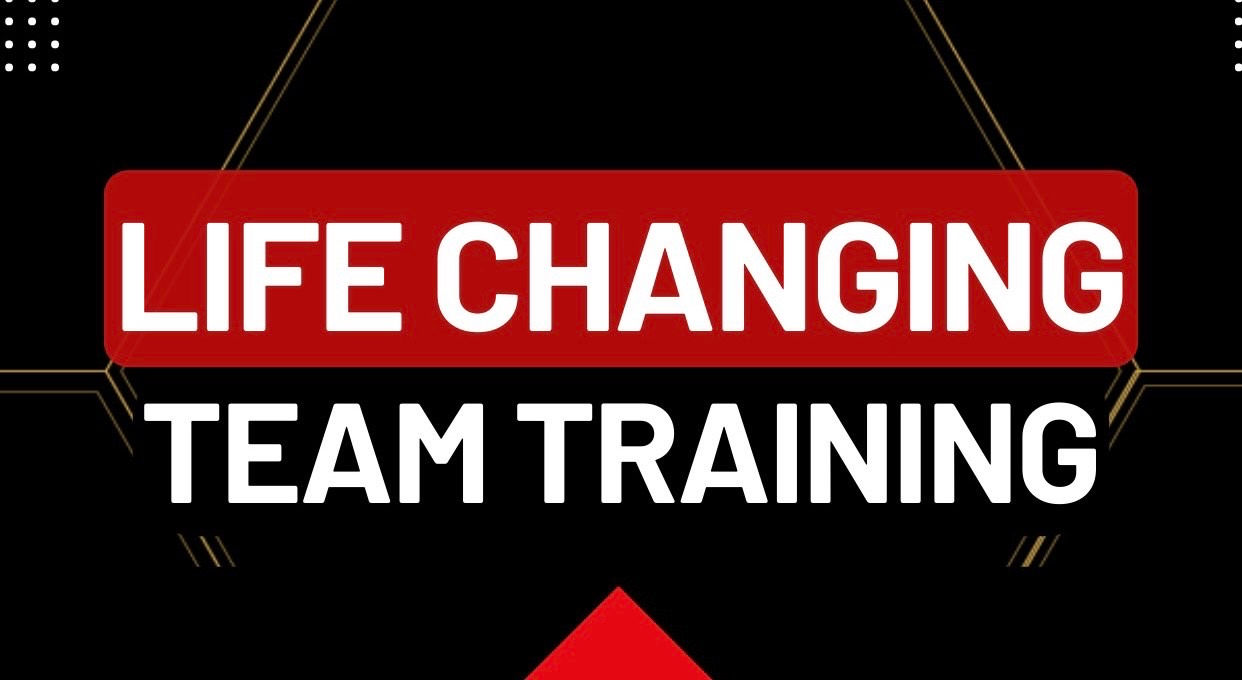Maximizing Potential: A Strategic Guide to Effective Leadership Training

What makes leadership training crucial for you or your organization? It’s about much more than learning to take charge. Real leadership involves mastering a blend of skills that inspire teams and drive results.
At Team Engage, we believe in the power of team training to gain results from every human on your team. We use the most advanced human development techniques, next-level sales training and little-known social media strategies to train your employees to supercharge growth and lower turnover.
Our guide explores tangible skills like strategic planning, clear communication, and adaptive thinking that leadership training offers, which are key for anyone looking to lead with confidence and creativity. Throughout this article, expect to uncover practical insights on tailoring training to fit the needs of your team and aligning it with the wins you’re aiming for.
Key Takeaways
- Leadership training is a multidimensional process aimed at enhancing essential leadership competencies for all organizational roles, aligning with company goals, and boosting job satisfaction and performance.
- Emotional intelligence, effective communication, strategic thinking, and decision-making are central to leadership training, fostering leaders who can navigate complex challenges, influence others, and drive organizational success.
- Measuring the effectiveness of leadership training involves assessments, feedback, and analyzing organizational metrics, with continuous professional development and experiential learning as key components for sustained leadership growth.
Exploring the Essence of Leadership Training

Leadership training, at its core, is the process of enhancing an individual’s capacity to guide and influence others towards achieving common goals. It’s a comprehensive journey that focuses on refining a variety of essential skills such as decision-making, communication, problem-solving, and adaptability. Importantly, it’s not limited to those in formal leadership positions. Every member of an organization, regardless of their role, can benefit from honing their leadership abilities.
A robust leadership development program provides a multi-stage process that evaluates current leadership competencies, imparts new knowledge, and empowers individuals to apply effective strategies in their leadership roles. The ultimate goal? To equip team members with the skills to guide others and deal with leadership challenges effectively. Such an investment in leadership training is a strategic move for organizations to retain top talent, providing them with career advancement opportunities and a clear path for growth within the leadership development industry.
Defining Leadership Training
But what does leadership training really entail? It’s a process that organizations invest significant time and resources into, aiming to develop key leadership skills based on modern leadership models. These skills, often referred to as ‘soft skills,’ are employed in various situations and are closely tied to effective communication and the ability to influence others.
The purpose of leadership training is to:
- Refine, develop, and implement leadership effectively within the organization
- Define leadership within an organization by consulting leaders and potential leaders to understand essential qualities and aligning them with the company’s current priorities
- Tailor the leadership training to the specific needs and goals of the organization, maximizing its effectiveness
Key Objectives of Leadership Training
Leadership training is designed with specific objectives in mind. One of the key goals is to develop essential leadership competencies. These competencies are honed to provide a personalized learning experience that prepares leaders to tackle challenges and adapt to new situations.
Another critical goal of leadership training is to enhance organizational culture. This is achieved through the development of self-awareness and interpersonal skills in leaders, leading to a more effective and empowered team. Furthermore, leadership development programs are aligned with the organization’s business objectives to ensure that leadership competencies are relevant to current goals and challenges.
For instance, C-suite executives at a company might be given targeted objectives in their leadership training, like improving communication abilities for effective conflict resolution.
Identifying Core Leadership Competencies

Identifying core critical leadership competencies is a pivotal step in structuring effective leadership development programs. These programs focus on developing leadership competencies, building key skills such as:
- Influencing
- Strategic thinking
- Delegation
- Coaching
- Mentoring
- Executive presence
- Resilience
These programs aim to improve the skill sets, abilities, and confidence of individuals, all of which are crucial for leading strong teams and ensuring success in organizational initiatives. However, it’s important to note that leadership skills aren’t static – they can and should be continually improved through:
- Practice
- Supporting and coaching colleagues
- Demonstrating responsibility
- Engaging in ongoing learning opportunities.
Building Effective Communication Skills
Effective communication is a cornerstone of proficient leadership. Leaders who excel in communication can:
- Efficiently convey organizational challenges and opportunities
- Foster informed decision-making that aligns with company objectives
- Keep employees informed about goals, boosting job satisfaction, morale, and confidence
On the flip side, poor communication can demotivate and hinder productivity.
Leadership training programs enhance a leader’s ability to think with clarity, express ideas effectively, and manage the rapid flow of information both internally and with external stakeholders. This training encompasses skills like active listening and providing effective feedback, which are essential for understanding and guiding team members.
Furthermore, emotional intelligence is bolstered through leadership training, enabling leaders to better understand and respond to team members’ emotional cues and communication preferences.
Nurturing Emotional Intelligence

Emotional intelligence is another critical area that’s nurtured through leadership training. It’s crucial for leaders to manage their own emotions and those of others, as this influences team dynamics and organizational success. Senior leaders, in particular, need to develop their emotional intelligence to:
- Connect
- Listen
- Coach
- Understand everyone they work with effectively.
Empathy is a key aspect of emotional intelligence that enables leaders to recognize and validate the feelings and experiences of their employees, fostering a valued and motivated workforce. When leaders display empathetic leadership, it creates a positive and supportive work culture, where employees feel valued, leading to increased satisfaction and productivity.
Strategic Thinking and Decision-Making
Strategic thinking and decision-making are other vital competencies that leadership training seeks to enhance. Leadership training encourages innovative thought processes and sets a clear vision to align teams towards common goals. Effective leadership training equips leaders to analyze complex information and consider potential risks and outcomes, fostering agile decision-making capabilities.
Trained leaders apply their skills by employing scenario planning for various outcomes, leveraging analytics for data-informed decisions, and communicating their choices effectively. Furthermore, risk management is an integral part of strategic leadership training, allowing leaders to identify, evaluate, and mitigate potential negative impacts of decisions.
The Impact of Leadership Styles on Training Outcomes

Leadership styles have a significant impact on the outcomes of training programs. Inclusive leadership, for instance, fosters a culture of diversity and inclusion. This impacts training by encouraging authenticity in the workplace, which in turn, shapes outstanding future leaders.
Effective relationship management by leaders is crucial for conflict resolution, trust-building, and fostering collaboration, all of which are enhanced through training. On the other hand, servant leadership values commitment and trust. When built into training, this can improve performance but may require additional training elements to bolster decisiveness and structure.
Adapting Training to Leadership Styles
One size does not fit all, especially when it comes to leadership training. Tailoring leadership training to individual leadership styles can improve its effectiveness by aligning with the psychological needs and preferences of leaders. This is because great leaders are those who can adapt and navigate through different leadership styles as circumstances change.
The process of adapting leadership styles involves observing the situation, setting aside ego, and asking critical questions to determine the best course of action for the team. Implementing a new leadership style may cause initial discomfort, but confidence and conviction in the chosen style are key to effective adaptation.
Structuring Leadership Development Programs for Success
For a leadership development program to be successful, it’s crucial to have a structured approach. This begins by identifying each participant’s baseline competencies and the opportunities for growth aligned with organizational goals.
Designing a successful leadership development program entails:
- Making it easily accessible and engaging
- Creating a branded learning experience that addresses both global consistency and regional specificity
- Identifying organizational sponsors
- Creating a clear deployment plan
- Assembling a dedicated team to manage the process
Effective implementation of these steps will help ensure the success of your leadership development program.
Importantly, sustaining and improving the best leadership development programs relies on continuous feedback, ensuring they stay relevant and have a lasting impact on the organization.
Integrating Experiential Learning
Experiential learning is a powerful tool when integrated into leadership training. There’s no substitute for hands-on practice in developing managerial soft skills, and experiential learning provides just that.
Experiential learning in leadership training leverages role-play, mixed team collaborations on problem-solving, and interactive case studies to enhance leadership effectiveness and collaboration. Real-time case studies and job rotations provide participants with insights into organizational dynamics and strategic thinking, connecting training with real-world business situations.
Continuous Professional Development
In the fast-paced business world, continuous professional development is a necessity. A leadership development plan that engages employees via ongoing learning opportunities builds key skills aligning with organizational priorities and fosters a culture of trust and innovation.
Continuous learning as part of leadership training helps leaders in the following ways:
- Keep abreast of industry trends and emerging technologies, which is crucial for informed decision-making
- Develop resilience, a critical aspect of leadership, which equips leaders to better manage unforeseen challenges in the workplace
- Support sustained organizational growth
The Role of Senior Leaders in Fostering Leadership Growth

Senior leaders play a pivotal role in fostering leadership growth. Their role includes:
- Creating a vision for the future of the company
- Defining leadership success for the coming years
- Nurturing a culture of belonging
- Shaping outstanding future leaders
When senior leaders actively engage in their own learning and development, they create a positive ripple effect that fosters a growth mindset across the organization. Additionally, senior leaders are instrumental in recognizing and promoting individuals based on leadership qualities such as empathy, consistency, accountability, and the ability to listen.
Mentoring and Coaching as Development Tools
Mentoring and coaching are essential development tools in leadership training. While coaching is a formal, one-on-one relationship focusing on specific skills or goals, mentoring is an informal, often long-term relationship supporting a broader scope of leadership skills.
Leadership coaching provides a tailored approach with assessments and individualized goals. In contrast, mentoring leverages more experienced employees to guide less experienced ones and can also occur as peer mentoring. Organizations can maximize benefits by combining coaching for performance enhancements and mentoring for cultivating long-term developmental relationships.
Measuring the Effectiveness of Leadership Training
The effectiveness of leadership training can be measured in multiple ways, including:
- Pre-and post-program assessments
- Peer evaluations
- Supervisor feedback
- Retention and implementation follow-up surveys at designated intervals.
Incorporating organizational metrics such as employee engagement or turnover rates into the evaluation insights and using stakeholder feedback methods like 180-360 evaluations, ensures a comprehensive understanding of leadership training impact.
Long-term effectiveness of leadership training can also be gauged through analysis of participants’ career progression, performance post-training, and the overall company performance and growth.
Tracking Progress and Performance
Technology-enabled tracking and measurement in leadership development programs allow for tracking individual goals, participation, engagement, goal progress, and skill development. Continuous 360-degree leadership assessments in a leadership development plan are crucial for monitoring progress and ensuring that the goals of the program are met.
Leadership development programs should include a feedback loop between project team members and program owners to share lessons learned and seek help, ensuring ongoing improvement and adaptation.
Developing Leaders Across the Entire Organization
Developing leaders across the entire organization is an integral part of the leadership development journey. Cultivating a culture of learning within an organization can increase employee engagement and retention through continued professional development.
Implementing training programs and motivational strategies, including rotational assignments, is vital for developing leadership skills across all levels of an organization. It’s no surprise that leadership development is a top priority for HR leaders, emphasizing its strategic importance in human resources planning.
Inclusive Leadership Development
Inclusive leadership development is a key aspect of a comprehensive leadership development strategy. Diversity, equity, and inclusion (DEI) should be prioritized in leadership development through targeted initiatives such as DEI training and promoting open dialogue for feedback.
To promote inclusive leadership development, it is essential for organizations to actively recruit women, minorities, and other underrepresented groups into their leadership training programs. Customized and actionable leadership development opportunities should be provided to high-potential individuals to nurture inclusive leadership competencies.
Navigating New Challenges with Adaptive Leadership Training
In today’s fast-changing business landscape, leaders must be prepared to navigate a wide range of demands and new challenges. This is where adaptive leadership training comes into play, fostering adaptability to navigate and guide organizations through constant changes in the business landscape.
Programs such as the Adaptive Leader Program by TCU Neeley Executive Education focus on equipping leaders with skills to navigate:
- complex organizational settings
- industry changes
- market disruptions
- staffing challenges
- shifts in organizational cultures
Furthermore, leadership training that includes crisis management skills prepares leaders to confront unexpected and disruptive events, ensuring they are proficient in leading through periods of crisis which is critical for maintaining business continuity.
Preparing for the Future of Work
Traditional executive leadership education often focuses on discipline-based skills and lacks preparation for modern challenges. However, future-oriented leadership training programs, such as the ‘Leading the Future of Work’ course by MIT Sloan, address key challenges for leaders such as:
- globalization
- automation
- AI
- wealth inequality
- climate change
Such training caters to:
- Business leaders
- Managers
- HR professionals
- Policymakers
who seek to understand and adapt to the implications of the changing work landscape on their careers and organizations. Leadership training now emphasizes the importance of updating the social contract to improve job quality and address inequalities in the light of future work environment changes.
Team Engage for Leadership Training for your Corporation

We at Team Engage stand out as a premier choice for team leadership training, offering a transformative experience that empowers leaders and teams to excel in today’s dynamic business environment. With a focus on practical, real-world application, our programs are designed to enhance communication, collaboration, and problem-solving skills, which are essential for effective team leadership.
Our expert trainers, with extensive experience in various industries, provide personalized guidance to ensure that learning is tailored to the unique needs of each organization. By choosing us, you’re investing in a proven methodology that not only boosts team performance and morale but also drives tangible results, setting your organization on a path to sustained success.
Team Engage will help build a culture, achieve results, and help teams win for your organization. Whether you’re looking to develop new leaders, enhance existing leadership skills, or foster a culture of teamwork and innovation, we are your ideal partner in achieving these goals. Contact us today to get started!
Frequently Asked Questions
Why is leadership training important?
Leadership training is important because it teaches the skills needed to lead effectively, including persuasion and influence, and widens thinking abilities to think in innovative ways. This allows leaders to succeed in leading others and addressing challenges effectively.
What is professional leadership training?
Professional leadership training involves participating in programs that challenge and hone an individual’s leadership skills, providing opportunities for reflection and team building to inspire goal achievement. Good leadership emphasizes motivating and inspiring team members while aligning their goals with the organization’s objectives.
What are the 5 phases of leadership development?
The five phases of leadership development are establishing trust, cultivating leaders, discerning vision, implementing plans, and transitioning out. These phases form the leadership life cycle, providing a distinctively Christian perspective on leadership.
How can the effectiveness of leadership training be measured?
The effectiveness of leadership training can be measured through pre-and post-program assessments, peer evaluations, supervisor feedback, and retention and implementation follow-up surveys at designated intervals. These methods provide comprehensive insight into the impact of the training.
What is the difference between coaching and mentoring in leadership training?
In conclusion, coaching focuses on specific skills or goals in a formal, one-on-one relationship, while mentoring supports a broader scope of leadership skills in an informal, often long-term relationship. I hope this helps clarify the distinction.

